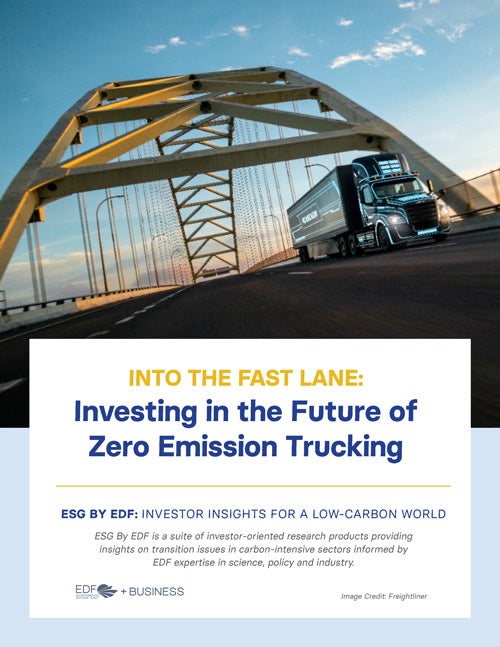Into the Fast Lane: Investing in the future of zero emission trucking
Into the Fast Lane: Investing in the future of zero emission trucking
Medium- and heavy-duty trucks are a major source of CO2 and air pollution; making the transition to zero-emission trucking is critical to net zero pathways.
If global commerce had a mascot, it might be a truck. Trucks are ubiquitous – a critical means to get raw materials to manufacturers and finished goods to consumers. Equally familiar are the exhaust plumes that so often trail behind those vehicles.
Medium- and heavy-duty (MHD) trucks are a major source of pollution, generating significant climate-warming emissions as well as particulates and other pollutants that are harmful to human health.
For companies, reducing trucking emissions not only reduces those climate and health impacts, but also represents best practice from a risk management and governance perspective. For investors, assessing companies’ adoption of and progress on ZE trucking goals is a means of identifying ESG leaders.
In this report we focus on the central role of carriers (trucking service providers) and shippers (trucking service users) in driving the transition to ZE trucking.
Report Highlights
- Medium- and heavy-duty trucks are a major source of CO2 and air pollution. Over 30 million trucks on US roads generate 7% of US greenhouse gas emissions – more than aviation, maritime shipping and rail combined. Trucks also negatively impact human health, disproportionately affecting overburdened communities.
- Eliminating truck-related climate pollution is critical to net zero pathways. To achieve climate goals, companies that use road freight should take steps to eliminate truck-related emissions. By tackling this issue head on, companies can reduce transition risks and maximize the benefits from adopting zero emissions technologies.
- Investors should call for faster action from carriers and shippers. Many companies that own or use trucks have not yet set clear strategies and commitments around decarbonizing road freight. Investors should press them to do so.
Our Recommendations
Investors should seek the following commitments from carriers and shippers:
- Commit to zero emission trucking by 2040. This should be part of a broader freight decarbonization strategy.
- Set interim ZE trucking goals, with application-specific targets. We
recommend application-specific interim targets, reflecting the phased commercial availability of ZE vehicles for different use cases, on the path to zero emissions by 2040. - Commit to deploying ZE trucks to pollution-burdened communities first. Companies should assess the impacts of trucking facilities that they operate or use — such as distribution centers and warehouses – and the health and demographic profiles of neighboring communities.
- Advocate for clean transport policies at the state and federal levels. Carriers and shippers should support policies that accelerate the transition to ZE trucking and align their lobbying with those goals.


